|
1.
CENTRAL AND WEST AFRICA
Diversifying markets to maintain production
The slowdown in demand in China is becoming a serious
problem for operators in the region with saw and ply mills
seeing rising stocks and few significant orders. Almost all
companies are looking for new markets and for species not
commonly demanded for the Chinese market.
Some success is reported with increased sales of azobe and
bilinga for the Netherlands and Belgium markets. Efforts
are underway to encourage more sales of padouk and
doussie to Europe.
Demand in China is at a standstill for most species with
only ovangkol and okan of interest. Shipments of other
major species such as okoume and belli have almost come
to a halt.
It is reported that mills in Gabon and Congo, which
concentrated on okoume, have cut production and started
to lay-off workers. It is only sawnwood markets in the
Middle East that are stable at present.
Lay-offs have been reported by mills operating in Gabon’s
Special Economic Zone (GSEZ). The total stock of
okoume held by mills in the GSEZ is said to be close to
300,000 cu.m so purchases from independent operators
selling into the zone have been drastically reduced.
Companies in Gabon and across the region are having to
deal with high fuel costs. In Gabon gasoline sells at
CFA1,157 per litre for companies but for the public the
price is CFA657 per litre.
Demand for okoume and redwoods down
Reports from Congo mention the impact of the main rain
season which is disrupting forest operations and trucking.
Mills in Congo face the same problems as others with the
slowdown in demand for the Chinese market.
Mills have found that demand for okoume and the
redwoods has dropped sharply with only a slight interest
being shown in purchase of ovangkol and okan for
flooring.
The only market that is still active for sawn okoume is the
Philippines where monthly shipments of around 6,000
have been reported.
Call for better assessments and application of science
at CITES
A recent ATIBT newsletter says that Jean-Louis Doucet,
Professor at Gembloux Agro-Bio Tech/University of
Liège, has called for better assessments and research
results to be taken into account to guide decisions on
timber species listing by CITES.
ATIBT reports the conclusions of Dr. Loubota's work is
unambiguous and that neither padouk nor doussi?are
threatened and sustainable harvesting will not jeopardise
their existence.
Professor Doucet suggests the CITES listing of these two
timbers was because “the wood of these two species is
difficult to differentiate from that of species considered
threatened”.
See:
https://www.atibt.org/en/news/13257/cites-ban-on-timberspecies-scientists-call-for-better-assessments-and-considerationof-sustainable-management
Through the eyes of industry, challenges and
suggestions from Congo and Gabon
See:
https://www.ittoggsc.org/static/upload/file/20221209/1670578785177402.pdf
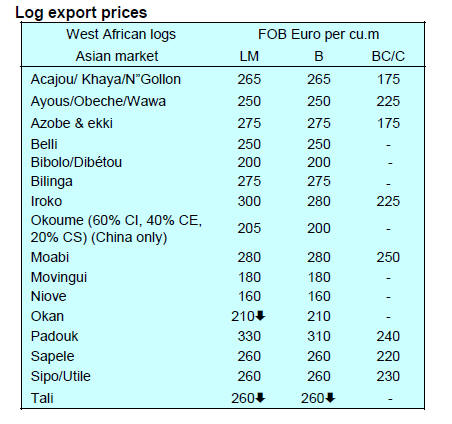
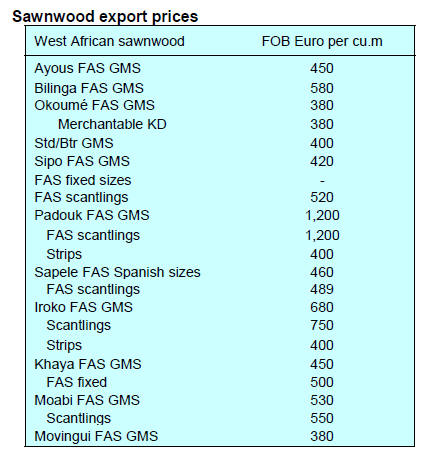
2.
GHANA
Cedi exchange rate holding up well
The Ghana cedi has recently been flagged as a top
performing regional currency against the US dollar, a
reverse of the situation three months ago when the
exchange rate suffered its worst downturn in years.
The Finance Minister, Ken Ofori-Atta, has expressed
confidence that government would soon reach an
agreement with the International Monetary Fund for a
programme aimed at restoring macroeconomic stability
and protecting the most vulnerable.
The Minster said the government is determined to
implement wide-ranging structural and fiscal reforms to
restore fiscal and debt sustainability and support growth.
See:
https://www.myjoyonline.com/ghana-cedi-from-worst-tobest-performer-against-dollar/
National EPA advisory council inaugurated
The Deputy Minister of Trade and Industry, Herbert
Krapa, inaugurated a National Economic Partnership
Agreement (EPA) Advisory Council as part of the
institutional arrangements for the implementation of the
EPA.
Ghana and the EU signed an interim EPA in 2016 which is
a bilateral trade and development agreement that seeks to
promote trade between the two blocks by reducing trade
barriers and tariffs imposed on imports of products
originating in the EU and Ghana.
The Council is expected to monitor the progress of
Ghana’s EPA and accompanying measures by providing
strategic guidance on project implementation and
compliance with applicable legislation, regulations and
standards.
In related news, the European Union (EU) has provided
Eur2.5 million for Ghana’s agricultural sector to help
increase farmers’ access to credit facilities.
See:
https://www.businessghana.com/site/news/business/276223/MoTI-inaugurates-the-National-Economic-Partnership-Agreement-(EPA)-Advisory-Council
and
https://www.ghanabusinessnews.com/2022/11/22/europeanunion-
injects-e2-5m-into-ghanas-agricultural-sector/
Digital equipment to monitor tree seedlings
Farmers in Ghana are using technology to monitor the
survival and growth rates of trees planted under the ‘Green
Ghana Project’. At a stakeholder meeting in the NW
Region of Ghana farmers were provided computers to
advance the reporting and monitoring of areas planted.
The event was arranged in consultation with the Forestry
Commission which has overseen the planting of over
270,000 economic tree seedlings in cooperation with the
Rainforest Alliance.
Alvin Adu Asare, Senior Associate, Geographical
Information systems in charge of monitoring and
evaluation at the Rainforest Alliance, said it was important
to track tree survival rates and to measure their progress
for informed decision-making.
See:https://newsghana.com.gh/rainforest-forest-alliance-trainsand-
supports-farmers-to-monitor-tree-seedlings/
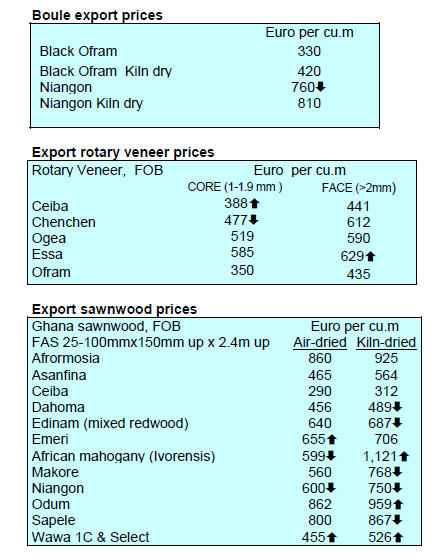
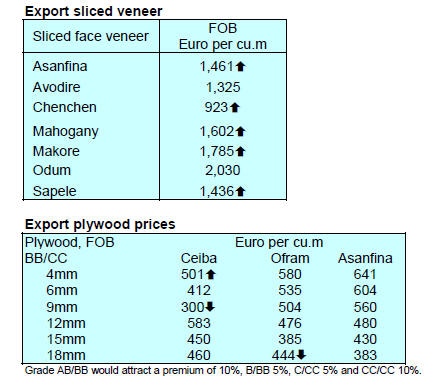
3. MALAYSIA
Carbon exchange launched
On 9 December Malaysia launched its Voluntary Carbon
Market (VCM) Exchange to drive the nation's
environmental and sustainability goals. Nik Nazmi Nik
Ahmad, Environment and Climate Change Minister said
the government is committed implementing climate
actions to further reduce the country’s carbon emissions
even though Malaysia’s share of global greenhouse gas
(GHG) emissions is only around 0.7%.
On the carbon trading policy the Minister clarified that
under the VCM no restrictions have been imposed on the
sales of carbon credits generated from projects located in
Malaysia to buyers outside of the country.
See: https://www.thevibes.com/articles/news/79649/govtcommitted-
to-cutting-carbon-emissions-tackling-climate-changenik-
nazmi
Labour shortage
The shortage of foreign labourers is still disrupting
production in many economic sectors. While the timber
sector is badly affected the plantations sector is facing a
worse situation. The Malaysian Palm Oil Association
(MPOA) is continuing to engage the Malaysian
government to resolve the chronic labour shortage issue
that has been plaguing the palm oil industry, especially
since the onset of the Covid-19 lockdowns in 2020.
MPOA Chief Executive, Joseph Tek Choon Yee, pointed
out that revenue lost due to the shortage of harvesters is
estimated to be about RM20 bil. The oil palm sector alone
is in need of 200,000 foreign workers.
See: https://www.thestar.com.my/business/businessnews/
2022/12/07/mpoa-revenue-losses-from-labour-shortage-atrm20bil
First woman CEO for Timber Council
The Malaysian Timber Council (MTC) appointed
Noraihan Abdul Rahman as its Chief Executive Officer
effective from 1 December. Noraihan replaces Muhtar
Suhaili. Noraihan, who was MTC's first woman Chief
Operations Officer, is now the Council's first woman CEO
in its 30-year history. MTC said she would oversee the
strategic direction and drive sustainable growth for the
council.
MTC said Noraihan's promotion was celebrated as a step
in the right direction for an industry that has few women in
its top ranks.
See:
https://mtc.com.my/corporate-ManagementTeam.php
Developing the market in France
Malaysian Wood Moulding and Joinery Council
(MWMJC) held an online meeting with the French Timber
Trade Federation (LCB) and the International Tropical
Timber Technical Association (ATIBT) to exchange
information on the Malaysian timber industry and French
market for tropical timber.
France is a traditional market for Malaysian wood
products and the aim of the meeting was to strengthen and
promote the existing good bilateral trading relations
between the two sectors.
Both sides discussed the possibility of further
collaboration between MWMJC and LCB/ATIBT
particularly in view of the potential demand for
sustainable timber products in construction projects for the
2024 Olympic Games in Paris.
Sarawak timber exports
Sarawak exported wood products valued at RM3.05
billion in the third quarter of this year compared to
RM2.92 billion for the corresponding period last year.
Japan remains the main importer of wood products
contributing RM1.88 billion or 62% of the total export
value in the third quarter of this year.
Other major markets were India (RM357 million), Middle-
East (RM134 million), China (RM131 million) and
Taiwan P.o.C (RM117 million). In terms of products,
plywood exports increased around 2.5% in value in the
third quarter to RM1.67 billion compared to RM1.63
billion for the third quarter 2021.
The State Government has indicated it intends to continue
to boost the industry by providing the necessary
infrastructure such as furniture testing laboratories and
sites for furniture parks in Demak Laut and Tanjung
Manis. The state government will also continue to increase
R&D collaboration with higher educational institutions,
research institutes and industry players to develop highly
competitive, value-added products.
See: https://www.thestar.com.my/business/businessnews/
2022/11/07/jaya-tiasa-hit-by-logging-suspension
New strategic plan for Heart of Borneo initiative
The Sabah government has launched a new Strategic Plan
of Action (2021-2023) to address emerging challenges and
take advantage of potential opportunities to enhance
conservation and management of the Heart of Borneo
(HoB) landscape. New features are introduced in the new
plan to further align its focus and address strategic shifts
critical to lift the Sabah HoB Initiative to a higher level.
Public awareness of the HoB and its conservation efforts
has always been a priority in Sabah. Over the past years,
roadshows, environmental education and training
programmes to promote the HoB Initiatives were
conducted for teachers and local communities.
The area of HoB in Sabah represented around 60% of
Malaysia’s Heart of Borneo landscape area and it holds
one of the remaining bastions of treasured biodiversity. A
total of 64% of Sabah’s landmass is protected forests of
which 52% are gazetted as Forest Reserves, State Parks,
Wildlife Sanctuary and also Wildlife Conservation Areas.
See: https://www.theborneopost.com/2022/12/02/sabahlaunches-
new-strategic-plan-of-actions-to-further-energise-hobconservation/
Dipterocarps The Dipterocarp tree species is the dominant
species in the
Southeast Asian rainforests. A new publication by the
Sabah Forestry Department, ‘The Sabah Red List of
Dipterocarpaceae’ documents the conservation status of
dipterocarps in Sabah. The mixed dipterocarp forests are
the most dominant vegetation type in Sabah with 182
species known to occur throughout Sabah.
Funded by the Federal Ministry of Energy and Natural
Resources (now Ministry of Natural Resources) this
publication documents the assessments carried out by
researchers from the Sabah Forestry Department, Forever
Sabah and Universiti Malaysia Sabah.
Of the 182 species of dipterocarps recorded in Sabah, 166
species (91%) are recorded within the Totally Protected
Area (TPA) system. More than half of the dipterocarps
were assessed as ‘threatened’ due to habitat loss. As for
species recorded outside the TPA system, they are either
assessed as threatened or the data is insufficient to make a
determination.
See: https://www.theborneopost.com/2022/12/09/182-species-ofdipterocarps-
recorded-in-sabah/rneo
‘Through the eyes of industry’, challenges and
suggestions from Malaysia
See:
https://www.ittoggsc.org/static/upload/file/20221209/1670578785177402.pdf
4.
INDONESIA
Raised export benchmark prices
The Ministry of Trade raised the Export benchmark price
(HPE) of wood products as of 1 December 2022.
A a press release from the Ministry of Trade says “There
is an increase in the Export Benchmark Price for wood
products, including sawnwood products of meranti which
are dried and leveled on all four sides so that the surface
became flat and smooth with a cross-sectional area of
1,000 sq.mm to. 4,000 sq.mm It increased by US$50 from
the previous month to US$900/cu.m and other species
were raised by US$150 from the previous month to
US$700/cu.m,”
The following are the Benchmark Export Prices of wood
products, which are valid in December 2022
Veneers
Natural Forest Veneer = US$800/cu.m
Plantation Veneer = US$550/cu.m
Wooden Sheet = US$800/cu.m
Chipwood
Chipwood in the form of particles = US$80/ton
Chipwood = US$90/ton
Processed Wood
Processed wood products which are leveled on all four
sides so that the surface becomes even and smooth with
the provisions of a cross-sectional area of 1000 mm2 to
4000 mm2 (ex 4407.11.00 to ex 4407.99.90)
Meranti (Shore sp) = US$900/cu.m
Merbau (Intsia sp) = US$1.050/cu.m
Rimba Campuran (Mix tropical hard wood)=
US$850/cu.m
Eboni= US$3.200/cu.m
Teak (tectona grandis) = US$1.400/cu.m
Pine and Gmelina (pinus merkusii and gmelina arborea) =
US$700/cu.m
Acacia sp = US$650/cu.m
Sengon (Albizia falcataria)= US$450/cu.m
Rubber (hevea braziliensis)= US$300/cu.m
Balsa (Ochroma sp), Eucalyptus sp = US$700/cu.m
Sungkai (Peronema canescens) = US$350/cu.m
Processed wood products which are leveled on all four
sides so that the surface becomes even and smooth of
merbau wood (Intsia sp) with a cross-sectional area of
more than 4000 sq.mm to 10000 sq.mm (ex 4407.29.91
and ex 4407.29.92): US$1,200/cu.m.
See: https://forestinsights.id/2022/12/02/kemendag-naikkanharga-
patokan-ekspor-hpe-kayu-bulan-desember-simakrinciannya/
Forest industry resilience in face of possible recession
The Ministry of Environment and Forestry (KLHK) is
preparing a strategic policy to strengthen the forestry
sector to face the threat of a possible global recession in
2023.
The Minister of Environment and Forestry, Siti Nurbaya,
said to maintain the productivity and sustainability of
forestry businesses, the government has provided a
number of incentives. Among them is the facilitation of
postponing and paying in an installment of Non-Tax State
Revenue (PNBP) for forestry business actors through
Ministerial Regulation Number 21 of 2021.
Indroyono Soesilo, chairman of the Association of
Indonesian Forest Concession Holders (APHI) identified
incentives that would be helpful in a global recession.
Among them is the implementation of the Job Creation
Law for the forestry sector, particularly in relation to the
implementation of multi-business forestry, the
implementation of satellite imagery-based work to identify
area boundaries and solutions for solving of non-forestry
development.
APHI also hopes that the government can revise the
Government Regulation Number 12 of 2014 concerning
Types and Tariffs of Non-Tax State Revenues that are
applied to the Ministry of Forestry, specifically related
to the payment of Reforestation Funds (DR) in Rupiah.
In addition APHI hopes that the government will
extend
the Ministry of Trade Regulation Number 19 of 2021
concerning export policies and arrangements regarding the
policy of expanding the cross-section for commercial
wood species that can be exported.
See: https://forestinsights.id/2022/12/07/klhk-perkuat-dayatahan-
industri-kehutanan-hadapi-resesi-2023-pengusaha-usulinsentif/
Scathing comments on EU Deforestation-free commodity law
According to a representative of the Indonesian
government, the new EU ‘Deforestation-Free Commodity
Law’ could become a trade barrier for a number of
Indonesian commodities and, if implemented, will be antimultilateralism
and discriminatory.
The Indonesian commodities that must meet the
requirements of the law are palm oil, beef, soybeans,
coffee, cocoa, wood and rubber. In addition, this law also
covers derivative products, including meat, furniture,
paper, leather and chocolate. The new EU law will not
allow these commodities and products to enter the EU
market if they were produced on land deforested or
degraded after 31 December 2020.
A spokesperson for the American and European Intraregional
Cooperation unit in Indonesia’s Ministry of
Foreign Affairs, Ms. Emilia H. Elisa, is quoted as saying
the EU regulation will have an impact on business actors
and even small producers in Indonesia.
According to Ms. Elisa, the Indonesian government views
the EU Deforestation Free Commodity Law as antimultilateralism
because it violates various international
and multilateral commitments. The Indonesian
government feels that the law also violates the legal
sovereignty of a country to make land-use decisions
regarding forests.
Ms. Elisa stated that the Indonesian government believes
that the EU policy is a form of discriminatory
action that violates WTO rules, especially Article XI of
the 1994 General Agreement on Tariffs and Trade
(GATT).
See: https://www.kompas.id/baca/ekonomi/2022/12/07/ri-sebutuu-
produk-bebas-deforestasi-ue-anti-multilateralisme-dandiskriminatif
Perhutani ready to supply raw materials
Perum Perhutani, together with the Indonesian Furniture
and Craft Industry Association (Asmindo), established a
Supply Chain cooperation mechanism for wooden
furniture and craft enterprises through a Memorandum of
Understanding agreed between the Commercial Director
of Perum Perhutani, Ahmad Ibrahim and the Chairman of
Asmindo, Dedy Rochimat.
Ahmad Ibrahim said that Perum Perhutani is open to
collaboration with SMEs. Asmido Chairperson, Dedy
Rochimat, said that Asmindo welcomed this collaboration
and hoped to obtain the best quality wood raw materials
from Perhutani so that it could increase selling power to
the global market.
See: https://wartaekonomi.co.id/read461921/perhutanidan-
asmindo-bersinergi-dalam-kemitraan-rantai-pasokfurnitur-
dan-kerajinan-berbahan-kayu
Through the eyes of industry, challenges and
suggestions from Indonesia
See:
https://www.ittoggsc.org/static/upload/file/20221209/1670578785177402.pdf
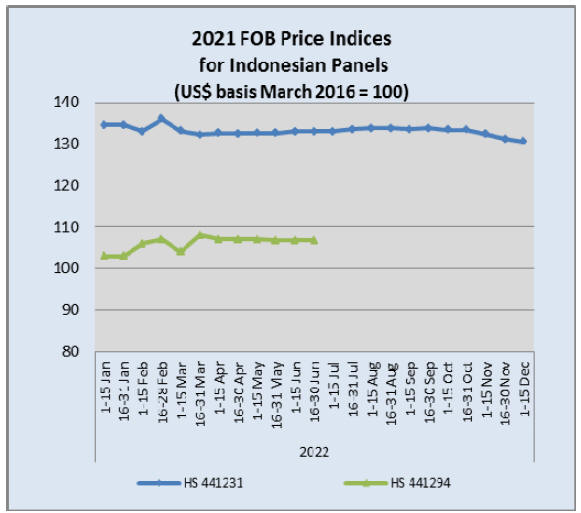
Data source: License Information Unit. http://silk.dephut.go.id/
5.
MYANMAR
Forest product exports
The news outlet ‘New Light of Myanmar’ has quoted the
Ministry of Commerce as saying more than US$94.28
million were earned from the export of forest products
from Myanmar from 1 April to 25 November 2022 of the
financial year 2022-2023. In the last financial year, 2020-
2021, exports totalled US$128.072 million and during the
2021-2022 earnings were US$83.901 million. Products
exported included teak, other hardwoods, plywood,
bamboo, cardamom seeds, wax, mustard oil, pine extract,
orchids, edible bird’s nest and straw.
In order to export timber and other forest products it is
necessary to obtain a certificate verifying legality of forest
products. Based on the verification of a ground inspection
team and confirmation of the chain of custody a certificate
verifying legality will be issued within two days by the
director of the Yangon Region Forest Department and the
relevant township Forest Departments.
See:
https://www.gnlm.com.mm/over-us88-million-earned-fromexport-of-forest-products/
and
https://www.gnlm.com.mm/usd-9-45-million-exceeded-inforest-products-export-within-eight-months-this-fy-more-thanthat-of-last-fy/#article-title
)
US proposes amendments to the BURMA Act
The US House of Representatives has approved legislation
that could decisively reshape future American policy
toward Myanmar if it becomes law. The newly-passed
National Defense Authorization Act (NDAA) included
an amended version of the BURMA Act which broadens
the government’s authority to impose sanctions against the
regime and aid Myanmar’s opposition.
The amended BURMA Act, along with the NDAA, will
become law only if it passes by a majority vote in the US
Congress’s upper chamber, the Senate. The NDAA is
typically passed by both chambers each year and a vote is
expected within weeks.
See:
https://rules.house.gov/sites/democrats.rules.house.gov/files/BILLS-117HR7776EAS-RCP117-70.pdf?fbclid=IwAR3kSdREEIZG4ycvca_kagy1m4k2BovBZQDr3JIdn7UVh-c9tCjQqZcFgHk
UN seeks diplomatic solution to the crisis in Myanmar
The UN General Assembly has adopted a resolution to
delay a decision on who will represent Myanmar at the
world body. The military rulers in Myanmar had sought to
replace the envoys who were appointed by democraticallyelected
government that was deposed last year.
The resolution was adopted without a vote and follows a
meeting of the UN Credentials Committee which approves
diplomatic representation of all 193 Member States. The
UN continues to push for a diplomatic solution to the
crisis in Myanmar, in the wake of the military takeover of
government in February last year.
See: https://news.un.org/en/story/2021/12/1107262
6.
INDIA
Indian rosewood handicraft exporters given
reprieve
Indian exporters of Dalbergia sissoo (Indian rosewood)
have been granted an exception under CITES for the
export of a limited range of furniture and handicrafts.
During the CITES meeting Indian participants successfuly
argued that Dalbergia sissoo is found in abundance in the
country and is not an endangered species. However,
because of the lack of easy to use technology for
distinguishing rosewood species the Indian timber was not
delisted.
See: https://timesofindia.indiatimes.com/india/india-gets-rulesfor-
export-of-rosewood-products-relaxed-during-cites-meet-inpanama-
move-to-help-artisans-andexporters/
articleshow/95666296.cms
Weak rupee dents panel product imports
The weakened rupee against the US dollar has made
imports more expensive and this has hit importers of panel
products, especially MDF.
At the beginning of the year there were reports of rising
MDF imports from Thailand, Vietnam and Sri Lanka as
freight rates dropped, but the sudden weakening of the
rupee exchange rate slowed the growth of imports and
gave a boost to domestic manufacturers.
See: https://www.plyreporter.com/article/93363/strong-dollarhits-
mdf-pb-import-growth-domestic-producers-safe-for-now
Timber not on the restricted list of Myanmar
commodities
Rajeev Bhattacharyya, a senior journalist writing in the
Irrawaddy, reports that the Indian government has
informed the Mizoram State authorities that timber is not
on the restricted list of commodities imported from
Myanmar. This followed a petition by an association of
wood-based industries in the state which believed timber
was on the restricted list of commodities.
India’s Minister of Commerce, Piyush Goyal, said that
only two types of timber – rough sandalwood and rough
red sanders are on the restricted list of imports from
Myanmar.
The author continued “trade between India and Myanmar,
both legal and illicit, supports large numbers of people on
both sides of the frontier” and it is likely that timber
imports from Myanmar will increase given India’s current
construction boom.
See: https://www.irrawaddy.com/opinion/guest-column/indiashould-
exercise-caution-over-myanmar-timber-imports.html
Banks lowering rates to sustain demand for home
loans
The house price index compiled by the Reserve Bank of
India (RBI) shows that housing prices appreciated by 4.5%
in the three months ending September. Housing demand
remains steady in India despite the rise in mortgage
interest rates.
To tackle inflation the RBI has steadily increased interest
rates since May which made loans more expensive but
recently some banks are lowering rates to sustain the
demand for home loans
See:
https://www.moneycontrol.com/news/business/markets/india-abright-
spot-in-shaky-global-realty-market-but-may-seepushback-
if-home-loan-rates-cross-9-5-clsa-9652551.html
Manufacturing output contracts
In the July-September quarter India's economic growth
slowed to 6.3% year-on-year after a double digit increase
in the previous quarter dented by inflation and global
pressures stemming from Russia's invasion of Ukraine.
The agriculture sector registered 4.6% growth in the July-
September period but manufacturing contracted reversing
the 4.8% expansion in the first fiscal quarter and well
below the 5.6% pace of growth in the corresponding
quarter a year earlier.
See: https://asia.nikkei.com/Economy/India-GDP-growth-slowsto-
6.3-amid-stubborn-inflation
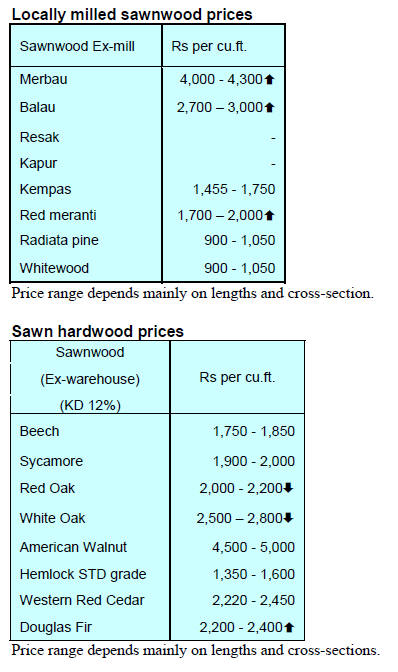
Plywood
Please note plywood prices are now shown below free of
local taxes.
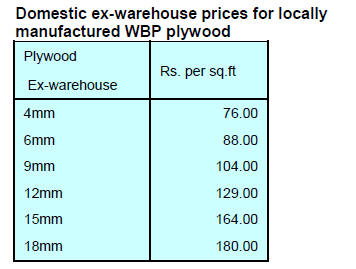
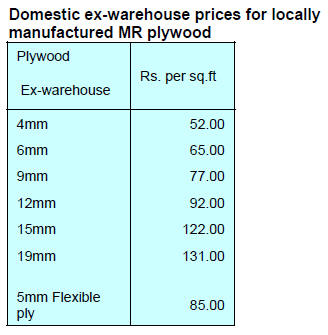
7.
VIETNAM
Wood and wood product (W&WP) trade highlights
According to Vietnam’s General Statistics Office W&WP
exports to the US market in November 2022 reached
US$550 million, down 7.5% compared to November
2021. Exports of wood and wood products to the US
decelerated sharply compared to the first 11 months of
2022.
In the first 11 months of 2022 exports of wooden furniture
are estimated at US$9.1 billion, up 1.1% year-on-year.
Vietnam's exports up 9% in 11 months
Vietnam exported nearly US$14.6 billion worth of
W&WP in the first 11 months of this year, up 9% year on
year.
Vietnam has a target to export US$16.5 billion worth of
W&WP in 2022. The high season for these products often
comes at year-end due to increasing demand for furniture
in major export markets. However, prospects are gloomy
this year.
In 2021 Vietnam earned over US$14.8 billion from
exporting W&WP which increased 19.7% year on year
and accounted for 4.4% of the country's total export
revenue with the US China, Japan and South Korea among
the major markets.
Between January and November this year Vietnam spent
more than US$2.8 billion importing W&WP, up 4.4% year
on year.
Vietnam’s W&WP exports/imports
In the first 10 months of 2022 exports of furniture (HS94)
accounted for 63% of total exports (down 6% over the
same period in 2021) while wood exports (HS44)
accounted for 31% (up 6%).
In 2022 exports increased sharply from January to August
adding over US$1.3 billion/month. However, exports
began to decrease from September 2022, adding US$1.1
billion/month.
Top export categories
The table below shows the volume and value of Vietnam's
W&WP exports in 10 months of 2022 and year-on-year
changes.
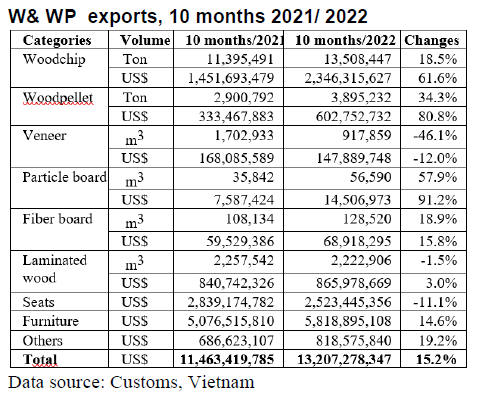
W&WP export commodities with important growth
include wood chips, pellets and furniture, while exports of
veneer and seats are decreased.
Export markets
The US, Japan, China, EU and South Korea are the 5 most
important markets of Vietnam’s W&WP. In particular,
the US remains as the top market
The table below shows Vietnam's W&WP exports to 5 top
markets and year-on-year growth. China and Japan have
the higher growth rates, followed by the EU and South
Korea.
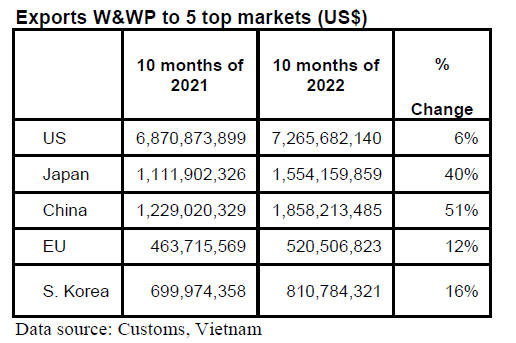
The important items that Vietnam exports to the US are
furniture belonging to HS 94 group while exports to China
relied on woodchips and exports to South Korea and Japan
are of pellets, wood chips and furniture.
Vietnam W&WP imports
In the first 10 months of 2022 W&WP imports amounted
to US$2.65 billion, up 7.3% over the same period in 2021.
Imports of raw material (HS44) contributed 86% of total
imports (year-on-year up 10%); furniture group (HS94)
accounted for 9.6% (down 13.4%).
Top import categories
Logs, sawnwood and veneer are of the main imports.
Imports of these 3 items in the first 10 months showed a
notable year-on-year decline except logs which increased.
Imports began dropping very sharply from September
2022.
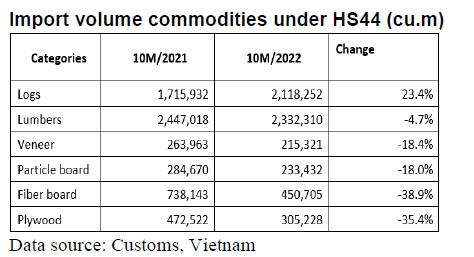
Import sources
China, the US, Thailand and Cameroon are Vietnam's
largest sources of imports. Imports from the main sources
are shown in Table 4. China is the largest W&WP supplier
followed by the US, Cameroon, Thailand, Brazil, Laos and
Malaysia. Vietnam imports boards and furniture from
China and logs and sawnwood from the US and
Cameroon. Thailand supplies wood-based panels to
Vietnam.
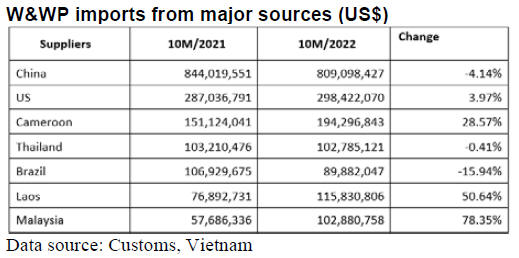
Log and sawnwood imports
Imports of logs and sawnwood accounted for over 60% of
the total imports in the first 10 months of 2022. The table
below shows the value of logs imported into Vietnam in
10 months of 2022 compared to the same period last year
by main sources.
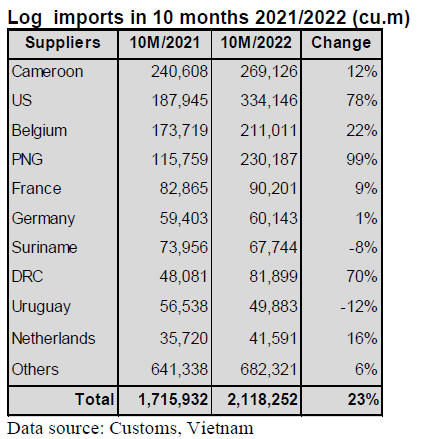
The table below shows sawnwood imports in 10 months
of
2022 compared to 10 months of 2021. Suppliers with the
largeest increases include the US, Belgium, Papua New
Guinea and Congo, while imports from Uruguay and
Suriname decreased.
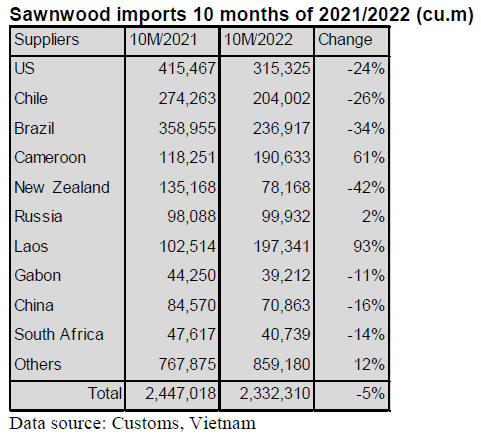
There were significant declines in imports from the
US,
Brazil, Chile and New Zealand while there were increases
from Laos and Cameroon.
See:
https://goviet.org.vn/bai-viet/viet-nam-xuat-nhap-khau-gova-san-pham-go-thang-10-2022-9891
8. BRAZIL
Mato Grosso companies win awards
During the 20th “Prêmio Referência” (Forestry Award of
Referencia Maganize) awards are given to companies in
the forest sector that achieved a high performance in
innovation and sustainability.
After an evaluation of the performance of the nominees
under the criteria financial investment, sustainability and
innovation and research, three forest companies in the
State of Mato Grosso (one of the main exporting states of
tropical timber in the Amazon) were among the winners of
the 2022 Forestry Award. All three companies are
members of the Center for Timber Producers and
Exporters of Mato Grosso State (CIPEM).
The main focus of the winning projects were studies and
measures to encourage better use of raw materials in order
to maximise yield through improvements in primary
processing to the final product.
These awards contribute to greater visibility on the efforts
of forest companys, promote good practices that
strengthen forest management with a focus on
sustainability and credibility along with encouraging the
search for continuous improvement in processing.
CIPEM emphasised the efforts of the Mato Grosso State
regarding the development of forest management by
implementing improvements in the safety and
transparency in the production and commercialisation of
forest products from the System of Commercialisation and
Transport of Forest Products - Sisflora 2.0.
See: https://cipem.org.br/noticias/empreendimentos-florestais-demt-
sao-destaques-da-20a-edicao-do-premio-referencia
Innovation centre for Bento Gonçalves
One of the largest furniture clusters in Brazil, the Bento
Gonçalves cluster, now has an innovation center, ‘Inova
Bento’ created during the First Innovation Forum. The
Centre is a strategic alliance between the Center for
Industry, Commerce and Services of Bento Gonçalves
(CIC-BG), the Association of Furniture Industries of the
State of Rio Grande do Sul (Movergs) and the City Hall of
Bento Gonçalves.
The Centre has four pillars of action: education;
investments; programme for startups; and programmes for
companies. On Education action will be on fora and the
so-called “demo-days” when teams from an open
innovation programme present projects to evaluators. The
Investments pillar will deal with the relationship with
investors and investment funds as well as with startup
accelerators.
The centre is a platform for sharing ideas and for
generating creative experiences, networking and
partnerships to drive solutions and entrepreneurship. The
implementation of ‘Inova Bento’ will be a breakthrough
for the production sectors in the municipality as well as for
the trade and services segments.
See: https://forestnews.com.br/setor-moveleiro-gaucho-ganhacentro-
de-inovacao-em-bento-goncalves/
Promoting Brazilian furniture exports
The Brazilian Trade and Investment Promotion Agency
(APEX-Brazil) and the Brazilian Furniture Industry
Association (ABIMÓVEL) have agreed to implement a
‘Brazilian Furniture Project’ in 2023/2024. This
initiative will promote the Brazilian furniture industry in
international markets. The investment for this 2 year effort
will be R$33.6 million, of which R$0.1 million will come
from Apex-Brasil and R$13.5 million from ABIMÓVEL.
The project strategy is focused on the three main pillars,
sustainability, design and competitiveness as elements that
add value in the sector. It is anticipated that around
US$850 million in business over the next 24 months can
be secured. There are currently almost 150 participating
companies in the project and about 80% of them are
already exporting mainly wooden furniture.
Despite the pandemic the furniture sector has maintained a
high level of exports with more than US$937.9 million
exported in 2021. The export destinations increased from
140 to 170 countries, reaching important markets and the
United States as the main purchasing country.
The growth in exports by companies associated with the
Brazilian Furniture Project topped 25% per year in the
period 2017-2021, higher than the national average and
much higher than the global average for the sector. Brazil
is the 6th largest furniture producer in the world.
See: http://abimovel.com/apexbrasil-e-abimovel-renovamconvenio-
com-investimento-de-r-336-milhoes-parapromocao-internacional/
Promising foreign trade platform
The ‘WoodFlow foreign Trade Platform’ is a Brazilian
startup for wood trading and was established in May 2022
and is already considered a reference point in exports with
traceability and credibility. The concept arose from the
desire of foreign buyers to get to know Brazil's wood
products better and the need for traders to actively
negotiate their products internationally.
Another aim of the platform is to detail the origin of forest
products and who is buying. This is done with videos that
show the forest operations and processing mills to bring
transparency to the negotiation table and guarantee that the
products are not from areas deforested.
The platform is promising because, despite being new, it
already has more than 170 registered export products
listed and has several markets destinations such as the
United States, India, Europe, Mexico and South Korea.
There is also input from an Indian company which buys
teak from Brazil and says the platform is good for
business.
See: http://www.madeiratotal.com.br/em-menos-de-um-anostartup-
woodflow-tem-mais-de-170-processos-cadastrados-deexportacao-
de-madeira/
Through the eyes of industry, challenges and
suggestions from Brazil and Mexico
See:
https://www.ittoggsc.org/static/upload/file/20221209/1670578785177402.pdf
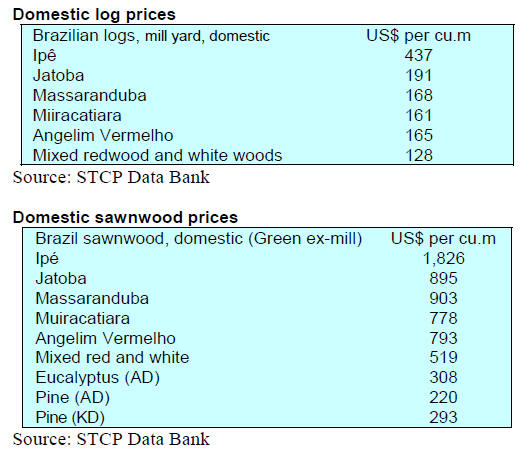
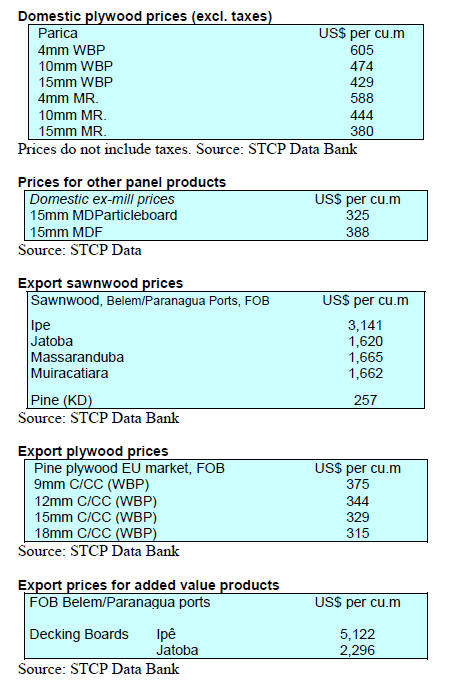
9. PERU
Addressing civil unrest
The recently installed President, Dina
Boluarte, established a "Crisis Cabinet" to guide on
measures to address the civil unrest. On 14 December a
nationwide state of emergency was declared to ensure
public order as well as to protect public and private assets.
The President said the cabinet team is made up of Cabinet
Chief, Pedro Angulo, as well as representatives of the
defense, interior, transportation-communications,
Development-Social Inclusion ministries as well as
the chief of the Joint Command of the Armed Forces.
See: https://andina.pe/ingles/noticia-peru-president-boluarteinstalls-
crisis-cabinet-to-promote-social-peace-921419.aspx
and
https://andina.pe/ingles/noticia-peru-defense-min-announcesdeclaration-
of-state-of-emergency-in-arequipa-for-30-days-
921428.aspx
Peruvian imports of wooden furniture
In the first nine months of 2022 the value of Peruvian
imports of wooden furniture was US$38.2 million, a sha
Brazil was the main supplier in the period with exports of
US$24.5 million which represented 64% of the total
imported in the period. China was the second largest
shipper at US$7 million followed by Colombia with
US$1.6 million.
Progress of the Pro-Bosques project
The Pro-Bosques project, which has been underway since
September 2018 and will culminate in September 2023,
was formulated to develop three objectives: to strengthen
the forestry sector through the adoption of a set of tools
that allow an agile and efficient forest management; to
generate greater profitability by promoting best practices
throughout the entire value chain of wood from the forest
to the market and finally to work in partnership with
indigenous organizations. Activities are conducted in the
regions of Lima, Loreto, Mother of God and Ucayali.
Around US$23 million in financing came from USAID
and US$2 million from NORAD.
The project reported the following outputs:
- The first Peruvian forest information system
developed to verify the legal origin of wood in
the country.
- 16 control and surveillance committees (CVC) in
Ucayali and Loreto to work in coordination with
the Regional Table for Control and Surveillance
of Forestry and Wildlife (MRCVFFS) and
indigenous organisations in both regions.
- CITEforestal Maynas, CITEforestal Pucallpa and
CITEmadera Lima improved the quality of
services provided to forestry users.
- Associations of small forest producers, in alliance
with municipalities and SERFOR, strengthened
their forest management in three local forests in
Ucayali and one in Loreto.
- The private sector strengthened its management
practices to ensure the legal origin and
traceability of the wood.
- National indigenous organisations and the
Peruvian government promoted an Indigenous
Forestry Agenda to promote a more inclusive
participation of communities.
- 16 indigenous communities of Loreto and
Ucayali implemented their ‘Life Plans’ in
coordination with representative organisations
and the authorities to develop 31 initiatives for
the sustainable management of biodiversity.
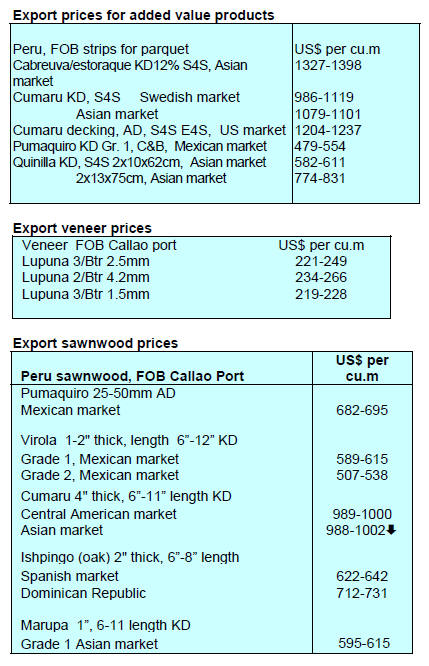
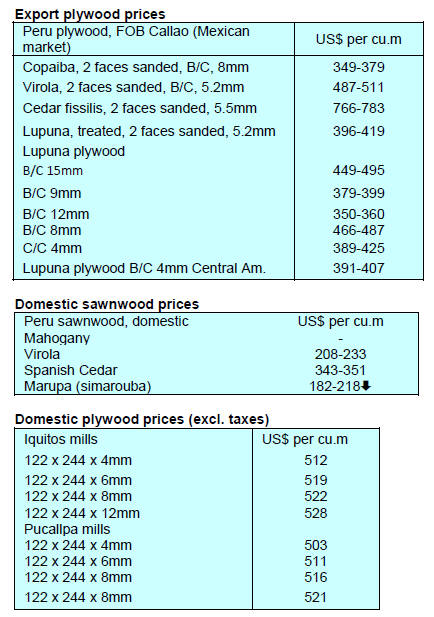

|